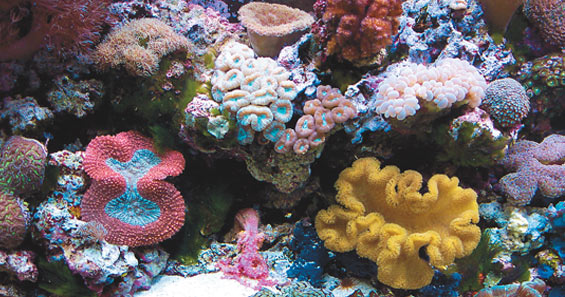
CONSIDER THIS
The intensity of the sun on the water's surface on the reef can reach values exceeding 120,000 lux. Due to changing weather patterns and air quality, it will average more in the range of 75,000 lux. Generally, the level of intensity on a reef with clear water will average about 20,000 lux at a depth of 15 feet, and 10,000 lux at 30 feet.
Metal Halide fixtures are the preferred lighting option for reef aquariums due to the intense illumination they provide. When selecting
Metal Halide bulbs for their light fixture, many reef hobbyists are preoccupied by the wide variety of wattage and color spectrum or Kelvin rating of these bulbs. While a bulb's wattage and spectrum can radically change the visible appearance of your home aquarium, coral health ultimately depends on providing the proper lighting intensity.
Light spectrum vs. intensity
Degrees Kelvin (°K) is the unit of measurement commonly used to describe spectrum or "color temperature" of metal halide bulbs. Though the K rating of a bulb informs reef hobbyists of light spectrum, it provides little or no information regarding how much light their aquarium inhabitants are actually receiving. Measuring light intensity, described by an international unit of measurement called a "lux," is the only true way to determine this.
What about watts?
Because a watt is actually related to a lux, wattage is often used as a general guideline in bulb selection. The higher the watts, the more intense the light, and the more energy will be used to produce the light. However, there is not an exact formula that can be used when determining the number of lux produced by a bulb of a certain wattage.
Why do you need a light meter?
Every photosynthetic coral species prefers different lighting intensity, but how can you determine the varying light levels in different areas of your reef aquarium so you can arrange them appropriately? Furthermore, as light enters the water and the different wavelengths are absorbed, the intensity of the light diminishes.
Professional hand-held lux meters take the guesswork out and help you discover even more creative possibilities for a stunning coral display. You can pinpoint the exact light intensity by depth, foreground vs. background, and even within the varying shadows of established structure. It's the testing and targeting you can only accomplish with a light meter that will really brighten your long-term results.
Having a
light meter in your arsenal of reef essentials also helps you monitor the optimal performance of your lighting system, telling you precisely when your bulbs need changing. While it may sound like an expensive tool reserved for only expert aquarists, highly accurate meters are actually quite budget-friendly to most hobbyists.
Question:
What is the best way to verify light conditions in my aquarium? |
Answer:
Hand-held lux meters remove the guesswork to provide a precise reading of how much light your aquarium inhabitants actually receive. You can pinpoint the exact light intensity by depth and even within the varying shadows of established structure. |
|